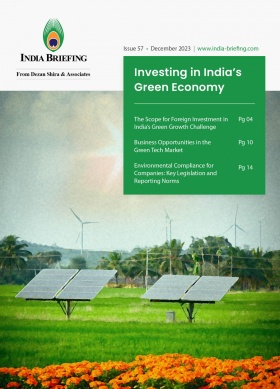Farm Mechanization in India’s Agriculture Sector: Challenges and Opportunities
Agriculture sector’s integral role in India
The Indian Parliamentary Standing Committee on Agriculture, Animal Husbandry, and Food Processing recently investigated farm mechanization and equipment spanning 2020-23. While representatives from the Ministry of Agriculture and Farmers Welfare provided a thorough briefing on the status of modernization in farming, it did raise concern about the lack of foreign direct investment (FDI) flow in the sector. The parliamentary committee meticulously reviewed and sanctioned the report during their meeting on July 14, 2023.
India’s farming and allied sectors play a pivotal role, supporting 17 percent of the global population and contributing 20 percent to the nation’s GDP. With an average growth rate of 2.8 percent, nearly half of the population relies on agriculture.
According to a 2022 report, 47 percent of agricultural operations in India are mechanized, which is lower compared to developing counterparts like China, with 60 percent, and Brazil, with 75 percent farm mechanization. Further, the mechanization levels range between 40-45 percent in states like Punjab and Haryana while it is negligible in other areas like the north-eastern states of India. The country’s agriculture landscape is dominated by small and marginal holdings, constituting less than 2 hectares, which cover approximately 86 percent of the total operational holdings. The small size of landholdings is one of the main causes of the decreased use of modern farming machinery.
In 2023, it was predicted that achieving 75–80 percent mechanization in the country would take approximately 25 years. While existing initiatives like the Sub-Mission on Agricultural Mechanization (SMAM) are promoting the adoption of modern equipment in farming, India must focus on prioritizing mechanization efforts specifically targeting small farms. Prospects exist for private sector-led innovation but that will require clear policies and incentives.
Farm mechanization as a catalyst for growth
The Indian agricultural machinery market is estimated at US$16.73 billion in 2024 and projected to reach US$25.15 billion by 2029. Major growth drivers include favorable government policies, rising farm incomes, and the imperative role of mechanization.
Farm mechanization proves instrumental in reducing cultivation costs and enhancing productivity through efficient resource utilization. As per India’s National Bank for Agriculture and Rural Development (NABARD), powered machines contribute 40-45 percent to various farm activities.
Approximately 50 percent of India’s population is employed in agriculture, which provides the majority of the country’s income and raw materials for numerous industries. The need for modern farm equipment arose from the increased production of grains, cereals, and oil seeds, which necessitates intensive harvesting procedures to maximize yield and minimize waste. The Ministry of Agriculture and Farmers Welfare (India) estimated that at the end of the fiscal year 2022, India had produced more than 288 million MT of cereals (such as rice, wheat, barley, millet, ragi, etc.). India is the second-biggest producer of wheat and rice worldwide. Therefore, farmers are pushed toward agricultural mechanization as a result of the increasing farming operations needed to maintain the output.
India’s farm equipment landscape
Agriculture, as a major industry, demands continuous modernization. The diversity in farming, whether large-scale or small-scale, necessitates a spectrum of agricultural equipment. From basic tractors to sophisticated combine harvesters, the sector requires a nuanced understanding of the equipment’s specific applications. Livestock farming, too, has its specific requirements, spanning feeding equipment, poultry tools, corral systems, and more.
Categorizing agriculture equipment manufacturing companies in India, the classifications include (i) tractors (less than 50 HP, 50 to 75 HP, 76 to 100 HP, 101 to 150 HP, greater than 150 HP); (ii) equipment (plows, harrows, rotovators and cultivators, seed and fertilizer drills, and other equipment); (iii) irrigation machinery (sprinkler, drip irrigation, and other irrigation machinery); (iv) harvesting machinery (combine harvesters, forage harvesters, and other harvesting machinery); (v) and haying and forage machinery (mowers and conditioners, balers, and other haying and forage machinery).
Challenges and opportunities for farm mechanization in India:
- While India has made progress in increasing power availability per hectare, with an increase from 0.3 kw in 1970 to 2.54 kw, the target of 4 kw per hectare by 2030 remains.
- There’s a direct correlation between farm power availability and yield, emphasizing the need to increase farm power availability.
- The proportion of budgetary allocation for the Department of Agriculture and Farmers Welfare (DA&FW) compared to the total budget of the Government of India has consistently decreased.
- Budget allocations for the Research and Development (R&D) to Farm Mechanization Scheme have seen a steady decline over the past four years, with a significant decrease of approximately 30 percent from 2019–20 to 2022–23.
- Rapid urbanization in India is leading to a shrinking agricultural workforce, with data showing a decline in the percentage of people employed in agriculture from 44 percent in 2017 to 41.4 percent in 2020. Shifting worker preferences from farm-oriented to allied industries contribute to labor deficits in agricultural operations. Manpower scarcity is expected to increase demand for farm equipment in the coming years, even as market demand will continue to accelerate.
- Tax and duty incentives to support manufacturing units in low mechanization areas are essential for sustainable growth.
- India’s farmtech startup sector raised US$1.1 billion in 2022, a slight drop from US$1.3 billion in 2021. In the coming years, funding attention is likely to get increasingly directed towards upstream agriculture technology or the production side of the agri-supply chain, as well as climate related agritech solutions and innovation.
Market outlook
(US$1 = INR 82.99)
About Us
India Briefing is produced by Dezan Shira & Associates. The firm assists foreign investors throughout Asia from offices across the world, including in Delhi and Mumbai. Readers may write to india@dezshira.com for more support on doing business in India.
We also maintain offices or have alliance partners assisting foreign investors in Indonesia, Singapore, Vietnam, Philippines, Malaysia, Thailand, Bangladesh, Italy, Germany, and the United States.
- Previous Article Mumbai Investment Profile: Economy, Infrastructure, Industries
- Next Article The OSH Code, 2020: A Primer









